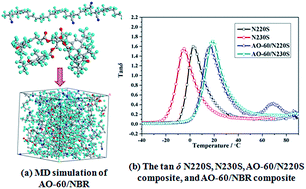Effect of acrylonitrile content on compatibility and damping properties of hindered phenol AO-60/nitrile-butadiene rubber composites: molecular dynamics simulation
Abstract
The effect of the acrylonitrile content in nitrile-butadiene rubber (NBR) on the compatibility and damping properties of AO-60/NBR was investigated by molecular dynamics (MD) simulation and experimental methods. The hindered phenol AO-60 had poor compatibility with NBR with an acrylonitrile content of 41% (denoted by N220S), but had good compatibility with NBR with an acrylonitrile content of 34% (denoted by N230S). The AO-60/N230S composite had larger H-bonds and higher binding energy than the AO-60/N220S composite at the same AO-60 content, both indicating stronger interactions between N230S and AO-60 and better damping performance of AO-60/N230S. Moreover, SEM, DSC, and DMA were used to evaluate the compatibility and damping of AO-60/NBR composites. Phase separation occurred between N220S and AO-60, but a fine dispersion of AO-60 in N230S was obtained. The present study hopes to provide theoretical guidance to the design of damping rubber materials.


 Please wait while we load your content...
Please wait while we load your content...